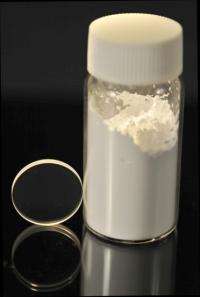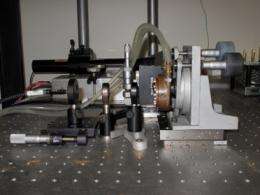Scientists demonstrate a high-efficiency ceramic laser

(PhysOrg.com) -- Scientists in the Optical Sciences Division at the Naval Research Laboratory, report a successful demonstration of a novel high-efficiency ceramic laser that is both, light-weight and compact for use in both military and civilian applications.
According to Dr. Jas Sanghera, a senior scientist on the program, "Solid-state crystal lasers are ideal for applications where light-weight and compact laser applications are important. But, these are difficult to grow due to high-temperature growth issues, which limit size and quality. However, researchers in our Optical Materials and Devices branch, have overcome these challenges by developing a low-temperature ceramization process to fabricate these hard-to-grow materials resulting in high optical quality."
This new process enables the densification or sintering of high-purity nano-powder at ~65 percent of the melting temperature. This avoids the traditional high-temperature problems associated with crucible reactions, volatilization and phase transitions, enabling the fabrication of a fully-dense and transparent ceramics material with optical-quality similar to single-crystals. This process has been applied to YAG, a hard synthetic yttrium aluminum garnet, used in laser technology, which is the workhorse of the solid-state laser community.

Scaling to significantly higher powers with good beam quality in YAG has its limitations, mainly due to its limited thermal conductivity and its sudden drop with increasing rare earth ion dopant concentration. A better solution is to use materials with higher thermal conductivity such as the sesquioxides Y2O3, Sc2O3, and Lu2O3. Of the three, the most important is Lu2O3, since its thermal conductivity is almost insensitive to the rare earth ion-dopant concentration due to the similarity of their phonon energies. For certain laser configurations requiring high-dopant concentration, such as thin-disk geometries, Lu2O3, has shown excellent promise for high-power scaling. Although, single-crystal Lu2O3 is difficult to make by traditional high-temperature crystal growing at >2400°C, the NRL research team has successfully fabricated laser quality rare earth doped Lu2O3 ceramics using the low-temperature sintering route.
The resultant ceramics were obtained by the synthesis of ultra-high purity Yb3+ doped Lu2O3 nano-powders, which were then hot-pressed to make a highly transparent Yb3+:Lu2O3 ceramic. The ceramics demonstrated lasing at 1080 nm with a world record high efficiency of 74 percent. "This result is remarkable considering the high doping level of 10 percent Yb3+. It paves the way forward for thin disk lasers, such as those based on Yb3+ at 1μm, that would have small path-lengths (100's μm), high-dopant concentrations (~10%), and the potential for TW high peak power short pulse lasers and multi-KW high average power lasers, both being pertinent to very high power laser applications on-board military platforms as well as commercial cutting and welding," concludes Sanghera.
Provided by Naval Research Laboratory


















